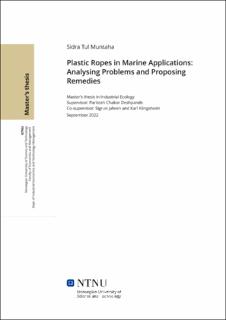| dc.description.abstract | Marine plastic pollution is a problem for both marine and terrestrial animals. Plastic polymers have entered the human food chain through micro and nano-plastic materials. Although globally, both land-based and marine-based sources contribute to the marine plastic pandemic, plastic waste from ropes dominates the marine waste fractions in the Nordic region. The case study depicting the fate, handling, and management practices of ropes in Norway has been chosen. This is important for Norway due to its long coastline and its economy being majorly dependent on fisheries and aquaculture activities.
The large volume of ropes used in fisheries and aquaculture are made from many different polymers and a composite of polymers and metals. The complex design, heterogeneous materials, and multi-actor involvement present significant challenges in closing the loop for ropes. Therefore, a large proportion of the ropes in Norway are eventually incinerated or exported for recycling abroad.
Static material flow analysis is performed to map the relevant stakeholders and volume flow along the lifecycle of ropes which indicates huge opportunities for material and monetary resources to stay within Norway. It was, therefore, relevant to study the material of ropes and their recyclability. With the aid of literature and interaction with the relevant stakeholders, a material inventory for ropes was created which is the holistic mapping of ropes based on their applications, properties, material types and ease of recycling.
Results show that the volume of ropes utilized in the aquaculture sector is considerably greater compared to the fishery. Ropes used in both sectors, fisheries and aquaculture, are mostly exported abroad, and only 7.5% are recycled in Norway. Inventory data demonstrates that 19 rope types have different material mixes and the recycling technology of most of these ropes is not known. Ropes were ranked according to the ease of recycling in Norway and this provides an overall directory for the recyclers in effective recycling as well as for producers to design to recycle at the end-of-life of the ropes. The research will also initiate a discussion by all the stakeholders, particularly on the need for industrial symbiosis, small circles, extended producer responsibility, labelling of ropes and eco-designing of ropes for improving their recyclability upon end-of-life. This will not only lead to ropes becoming circular but will also result in efficient use of resources, financial incentives, and employment generation. Overall, more responsibility is placed on producers and recyclers for closing the loop of ropes in Norway.
Keywords: Marine Plastic Pollution, Ropes, Material Flow Analysis, Recycling, Circular Economy | |
